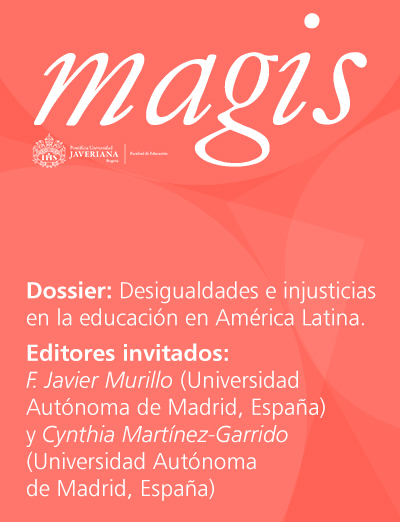Abstract
The objective of this article is to analyze, from the perspective of curricular justice, the educational and discursive practices, as well as the challenges encountered during remote teaching, by four students and four teachers from a telesecundaria (a type of secondary education in Mexico) in a marginalized community in southern Yucatán, Mexico. The study was conducted using a qualitative approach based on a case study design, which included in-depth interviews, observations, and content analysis of instructional materials and guidelines proposed by educational authorities. The results demonstrate the commitment of educators to engage with students through various means, as well as to safeguard their mental and physical well-being in order to sustain the educational process. However, it is evident that official initiatives tended to focus exclusively on the digitalization of information without appropriate adaptation to the emergent situation, thereby undermining fundamental principles of educational justice such as affordability, accessibility, adaptability, and acceptability. This situation highlights a significant gap between policy and social reality. The study concludes that a hegemonic curricular project prevails, perpetuating knowledge production mechanisms that sustain coloniality and exacerbate existing educational and social inequalities.
Aguilar, J. R. (2021). Vocación docente e influencia en el aprendizaje en escolares en tiempo de pandemia. Ciencia Latina, Revista Científica Multidisciplinar, 5(6). https://doi.org/10.37811/cl_rcm.v5i6.1240
Bozkurt, A., & Sharma, R. (2020). Emergency remote teaching in a time of global crisis due to coronavirus pandemic [Enseñanza remota de emergencia en un momento de crisis mundial por la pandemia del coronavirus] [Editorial]. Asian Journal of Distance Education, 15(1), i-vi. https://doi.org/10.5281/zenodo.3778083
Carro, A. & Sánchez, C. (2022). La educación básica a distancia en tiempos de COVID-19 desde el análisis de la estrategia “Aprende en casa”, en Tlaxcala, México. Revista Electrónica Educare, 26(3), 1-21. https://doi.org/10.15359/ree.26-3.27
Cerviño, C., Fernández, I., Tomás, J. M., & Córdova, S. (2016). Factores predictores del compromiso docente en escuelas públicas peruanas: un modelo estructural. Persona, (19), 43-54. https://doi.org/10.26439/persona2016.n019.970
Conell, R. (2012). La justicia curricular. Laboratorio de Políticas Públicas.
De la Cruz, G. (2016). Justicia curricular: significados e implicaciones. Sinéctica. Revista Electrónica de Investigación, 46, 1-16. https://hdl.handle.
net/11117/7195
Goddard, C & Wierzbicka, A. (2000). Discurso y cultura. En T. van Dijk (coord.), El discurso como interacción social. Estudios del discurso: introducción multidisciplinaria (pp. 331-366). Gedisa.
Hodges, C., Moore, S., Lockee, B., Trust, T., & Bond, A. (2020, 27 de marzo). The difference between emergency remote teaching and online learning [La diferencia entre la enseñanza remota de emergencia y el aprendizaje en línea]. EDUCAUSE Review. https://er.educause.edu/articles/2020/3/the-differencebetween-emergency-remote-teaching-and-online-learning
Instituto Nacional de Estadística y Geografía (INEGI). (2020). Censo de población y vivienda 2020. https://www.inegi.org.mx/programas/ccpv/2020/
Rogers, H., & Sabarwalha, S. (2020). Covid-19: impacto en la educación y respuestas de política pública. Grupo Banco Mundial. Educación.
Ruiz-Ramírez, R., García-Cué, J. L., Estrada Castro, K. E., Zapata-Martelo, E., & Ruiz-Martínez, F. (2023). Impacto de la covid-19 en estudiantes de preparatoria en comunidades rurales, México. Revista Latinoamericana de Ciencias Sociales, Niñez y Juventud, 21(1). https://doi.org/10.11600/rlcsnj.21.1.5332
Secretaría de Educación. (2020, 23 de marzo). Boletín No. 76. Convoca SEP a participar en educación a distancia durante receso escolar [Comunicado de prensa]. https://www.gob.mx/sep/es/articulos/boletin-no-76-convoca-sepa-participar-en-educacion-a-distancia-durante-receso-escolar?idiom=es
Stake, R. (1995). The art of case study research [El arte de la investigación por estudio de caso]. Sage.
Stake, R. (2010). Qualitative research: studying how things work [Investigación cualitativa: estudiar cómo funcionan las cosas]. The Guilford Press.
Tomasevski, K. (2004). El asalto a la educación. Intermón-Oxfam.
Van Dijk, T. A. (1999). El discurso como estructura y proceso. Estudios sobre el discurso I. Una aproximación multidisciplinaria. Gedisa.
Van Dijk, T. A. (2001). Discourse, ideology and context [Discurso, ideología y contexto]. Folia Lingüística, 35(1-2), 11-40.

This work is licensed under a Creative Commons Attribution 4.0 International License.



